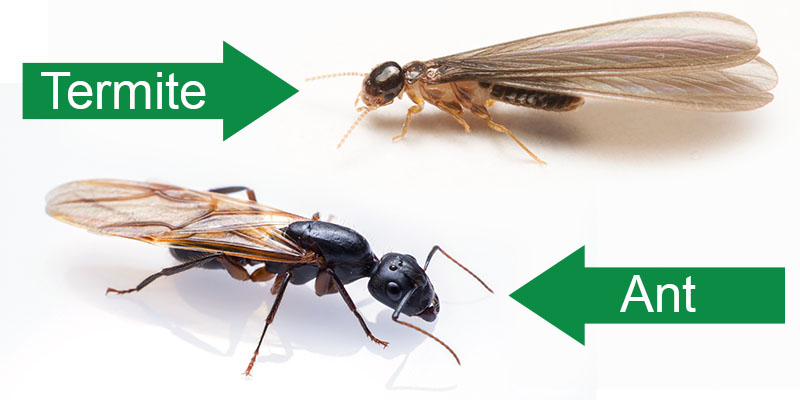Ants and termites are two distinct insect species, each with their unique characteristics and behaviors. However, due to their similar appearance, it can be quite difficult to distinguish between the two. Below, we’ll delve into the key differences between ants and termites, focusing on their physical characteristics, behaviors, and habitats. By understanding these distinctions, you can better identify and address potential issues in your home or property.
Are There Ants that Look Like Termites?
The short answer to this question is “yes.” There are indeed ants that do look like termites – probably because both species share similar shapes and sizes. So, let’s go ahead and take a detailed look at the physical differences between ants and termites:
- Antennae. Ants have elbowed antennae, while termites have straight antennae. This is a key distinguishing feature that can help you tell the two species apart.
- Body shape. Ants have a narrow waist, giving them a more distinct “hourglass” shape. Termites, on the other hand, have a more uniform body shape with a broad waist.
- Wings. Both ants and termites have winged forms, but their wings differ in appearance. Ants have front wings that are longer than their hind wings, while termites have wings of equal length. Additionally, termite wings are more delicate and can easily fall off, leaving behind a small, translucent wing.
Of course, it’s not just physical characteristics that separate these two pests. Termites and ants also act differently. Here are the basic behavioral differences between ants and termites:
- Diet. Ants are omnivores, consuming a wide variety of food sources, including other insects, seeds, and nectar. Termites, however, primarily feed on wood and other cellulose-rich materials.
- Nesting habits. Ants build nests in a variety of locations, such as underground, in trees, or even within the walls of buildings. Termites, on the other hand, construct large, elaborate nests in soil or wood, often creating intricate tunnel systems.
- Social structure. Both ants and termites have a caste system, with different roles and responsibilities for each member of the colony. However, the specific roles and appearances of each caste can vary between the two species.
Common Species of Ants and Termites
Since these two species can easily be confused and do share several similarities, it’s best to understand which are the most common. Although there are between 12,000 and 22,000 ant species globally and between 2,000 and 3,000 species of termites worldwide, we’ll take a look at the usual suspects, which are the following:
- Carpenter ants. These ants can be easily confused with termites due to their wood-dwelling habits. However, carpenter ants do not consume wood; instead, they excavate it to create their nests.
- Odorous house ants. These small, dark-colored ants emit a strong, unpleasant odor when crushed. They are often found nesting in wall voids or under floors.
- Subterranean termites. These termites are the most common type found in the United States. They live in underground colonies and build mud tubes to access food sources.
- Drywood termites. Unlike subterranean termites, drywood termites do not require contact with soil. They live and feed within the wood they consume, making them more difficult to detect.
While ants and termites may look similar at first glance, they have distinct physical and behavioral differences that can help you distinguish between the two. By understanding these differences, you can better identify and address potential issues in your home or property. If you suspect you have a termite or ant infestation, it is important to contact a pest control professional right away for proper identification and treatment.
How Do You Tell if a Bug Is a Termite?
Everyone knows that termites are small, wood-destroying insects that can cause significant damage to homes and other structures. So, it is important to be able to identify these pests to prevent and address infestations. But, how exactly do you do this? Well, there are some ways to tell if a bug is a termite and it begins with looking at their physical characteristics.
Physical Characteristics of Termites
Termites are small, soft-bodied insects ranging from 1/8 to 1 inch long. As previously stated, they have straight antennae and a broad waist, which distinguishes them from ants, which have elbowed antennae and a narrow waist. Termites have two pairs of wings that are equal in length and are usually white or translucent.
Behavioral Characteristics of Termites
Here again, termites are social insects that live in colonies with a caste system consisting of workers, soldiers, and reproductive individuals. They feed on cellulose, which is found in wood, paper, and other plant materials. Termites can cause significant structural damage to buildings and other wooden structures by consuming the wood from the inside out.
How to Tell if a Bug Is a Termite
Now, how do you tell if a bug is a termite? Well, fortunately, there are some telltale signs you can look for to help you identify the culprit. Here are some ways to tell if a bug is a termite:
- Examine the insect’s wings. Termites have two pairs of wings that are equal in length and are usually white or translucent. If the wings are not equal in length or are a different color, the insect is likely not a termite.
- Look at the body shape. Termites have a broad waist and a straight body, while ants have a narrow waist and a pinched body.
- Check the antennae. Termites have straight antennae, while ants have elbowed antennae.
- Observe the behavior. Termites live in colonies and feed on wood, while other insects may have different behaviors and diets.
- Consult a professional. If you are unsure whether what you see is a termite or another insect, it is best to consult a pest control professional for proper identification.
Remember, termites can cause significant damage to homes and other structures, so it is important to identify these pests. By examining the insect’s wings, body shape, antennae, and behavior, you can determine whether it is a termite. If you are unable to make a determination, it’s a good idea to have a pest control professional make a proper identification.

